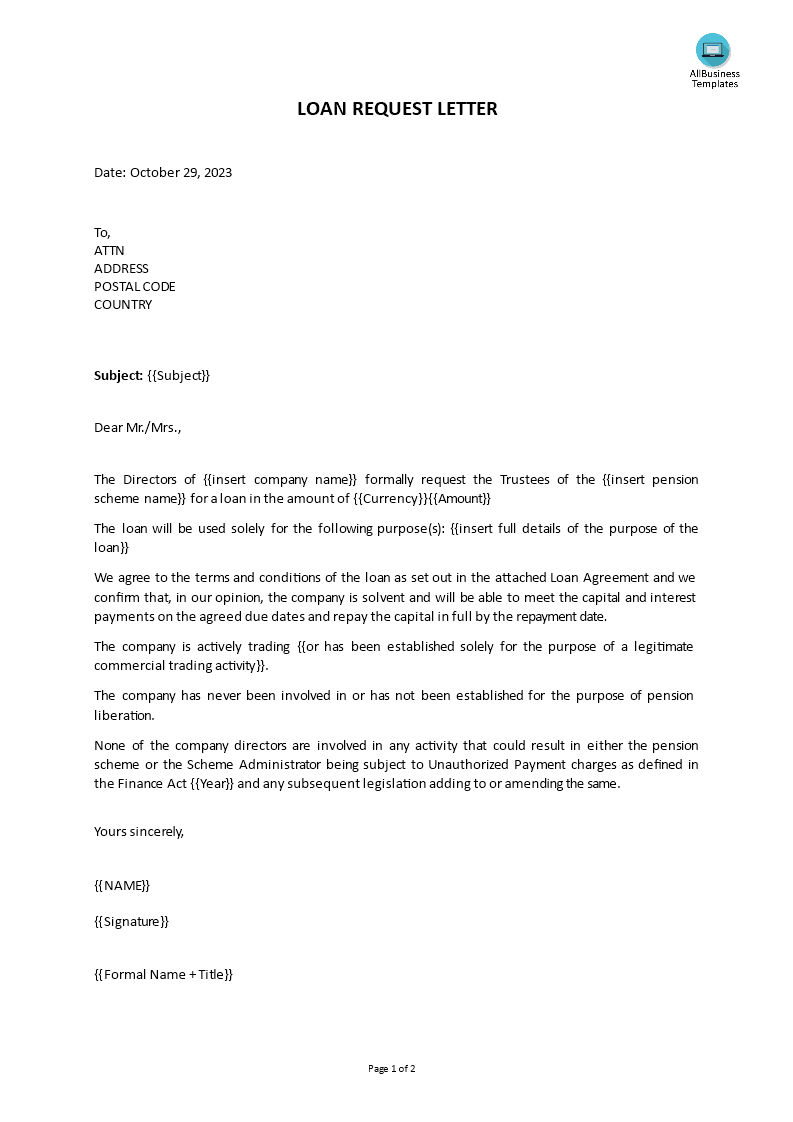Loan Request Letter
Save, fill-In The Blanks, Print, Done!

Download Loan Request Letter
Microsoft Word (.docx)Or select the format you want and we convert it for you for free:
Other languages available:
- This Document Has Been Certified by a Professional
- 100% customizable
- This is a digital download (28.24 kB)
- Language: English
- We recommend downloading this file onto your computer.
How to draft a loan request letter? Why is a loan request letter needed? We provide a sample loan request letter template to help you quickly and easily write a loan request. This template includes all the necessary information about the loan, such as the amount, purpose, and payment terms. It also includes a section for the borrower's signature. An easy way to start completing your document is to download this loan request letter template now!
A loan request letter is a formal written document in which an individual or an organization requests a loan from a financial institution or lender. This letter is typically the first step in the loan application process and serves as a formal request for the desired loan amount, including details about the purpose of the loan, the terms and conditions the borrower is seeking, and other relevant information.
Here are the key components typically included in a loan request letter:
- Sender's Information: This includes the name and contact details of the person or organization requesting the loan. In the case of a business, it would also include details like the business name, address, and contact information.
- Date: The date on which the letter is written.
- Recipient's Information: The name and address of the financial institution or lender to whom the loan request is being addressed.
- Loan Amount: Specify the exact amount of money you are requesting as a loan.
- Loan Purpose: Clearly state the purpose for which you need the loan. This could be for business expansion, purchasing equipment, covering operational expenses, education, home purchase, etc. Providing details about the purpose helps the lender understand the intended use of the funds.
- Loan Terms: Outline the terms and conditions you are seeking for the loan, including the desired interest rate, repayment period (e.g., the number of months or years you need to repay the loan), and any specific terms you would like, such as a grace period before starting repayment.
- Repayment Plan: Briefly describe how you intend to repay the loan. This could include the proposed repayment schedule or any collateral you are willing to offer as security.
- Financial Information: Provide a snapshot of your financial situation, including your income, assets, liabilities, and credit history. Lenders often require this information to assess your creditworthiness.
- Supporting Documents: Mention any documents or attachments that you are including with the letter, such as financial statements, business plans, or personal financial documents.
- Closing and Signature: Sign the letter and close it with a polite closing, such as "Sincerely" or "Yours truly," followed by your name and signature.
A loan request letter is a formal document that should be drafted carefully and professionally, as it sets the tone for the loan application process. It's important to be clear and transparent about your intentions, financial situation, and repayment capacity. Lenders use this letter to evaluate the loan request and decide whether to proceed with the application process. If approved, the loan request letter can serve as the basis for the loan agreement and the terms and conditions of the loan.
Download this loan request letter template now for your own benefit!
DISCLAIMER
Nothing on this site shall be considered legal advice and no attorney-client relationship is established.
Leave a Reply. If you have any questions or remarks, feel free to post them below.
Related templates
Latest templates
Latest topics
- Excel Templates
Where do I find templates for Excel? How do I create a template in Excel? Check these editable and printable Excel Templates and download them directly! - GDPR Compliance Templates
What do you need to become GDPR compliant? Are you looking for useful GDPR document templates to make you compliant? All these compliance documents will be available to download instantly... - Google Docs Templates
How to create documents in Google Docs? We provide Google Docs compatible template and these are the reasons why it's useful to work with Google Docs... - IT Security Standards Kit
What are IT Security Standards? Check out our collection of this newly updated IT Security Kit Standard templates, including policies, controls, processes, checklists, procedures and other documents. - Letter Format
How to format a letter? Here is a brief overview of common letter formats and templates in USA and UK and get inspirited immediately!
cheese




